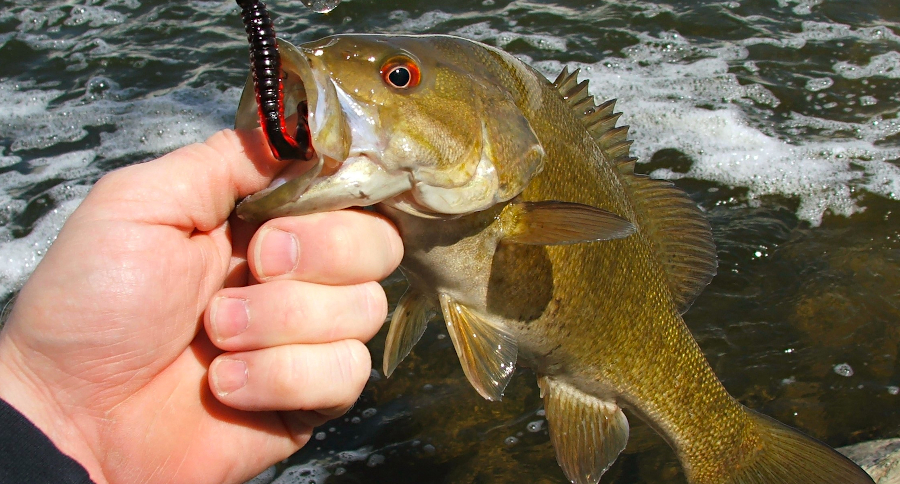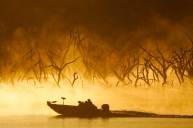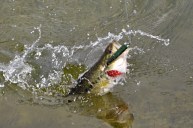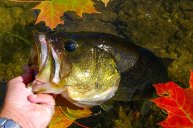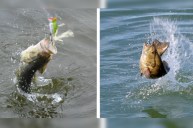Bass fishing doesn't have to end in winter.
Many bass anglers hang up their fishing gear during the cold weather of the winter months because it's so much harder to catch fish. This is especially true in northern states where the water temperatures dip to very low levels. I live in Michigan, so I feel your pain!
Actually, there are ways to make it happen even when the weather's cold and there's snow on the ground. We'll go over winter bass fishing in detail and cover a variety of techniques to fit any situation and part of the country.
By utilizing these bass fishing tips, you can continue to catch bass months before other anglers even consider heading out.
Winter bass behavior
Cold water bass are some of the toughest to fish for simply because their metabolism slows considerably this time of year. It gets worse the farther north you go. However, this doesn't mean the fish stop eating. It simply means they're a bit pickier about what they'll chase.
Wintertime is not the ideal scenario to be ripping huge spinnerbaits through shallow water or splashing a big topwater across the surface.
In most cases, the big bass are going to be found suspending in deeper water. A fresh cold front or dipping temperatures will only make the bite worse in most cases. However, bass can still be regularly caught ice fishing if you find the right spot.
One thing to keep in mind is that the southern states are going to see the bass warm up first. Bass in Florida and Texas might start spawning as early as February if water temperatures warm enough. In Michigan, where I live, spawning fish aren't even a consideration until late April or May.
Keep a thermometer in your boat and adjust accordingly. If the water is down in the 30s or 40s, the fish are going to be much more sluggish. When it gets up to the 50s and 60s, you can start getting more aggressive.
Keeping an eye on the weather is absolute necessity for fishing this time of year. For instance, if you've got one day where the sun is going to be shining and temperatures will be high, that's the day you should fish. Odds are, that slight warm up will trigger the fish to get active and feed.
Make sure you do your homework for the body of water you're fishing. Is it a lake with streams and feeder rivers running into it? If so, there may be deep water warm patches that are concentrating baitfish. Consider which part of the water is getting the most sunlight and may be the warmest. In some cases, a spot like this only works for winter fishing.
Use your electronics to locate more fish. This is especially helpful if the bass are hanging in 40-50 feet of water or more. You can also use topographic maps to help locate good-looking spots if you don't own electronics. Usually, finding them isn't that hard. Getting them to strike is a whole different story.
Winter bass lures
The colder months are generally a time for finesse techniques. The colder the water column, the more sluggish the fish will be.
Jigs resembling crawfish and drop shot worm rigs are a good way to start. Keep in mind the slow metabolism of the fish in colder waters. You must fish these lures much slower than you normally would. Bass don't want to expend a ton of energy chasing or killing a larger prey item. This why smaller lures usually out-perform larger ones.
Drop the sizes of your typical early spring and summer presentations. Winter is a great time to try something new like a simple "Ned rig," because it resembles a minnow slowly feeding across the bottom. A big lazy bass will find it hard to resist one of those slowly bouncing next to it as it holds on the bottom.
Many anglers also like jerkbaits, both hard-bodied and soft plastic for winter. However, keep in mind that you will need to slow your presentation significantly. Too fast and the bass will just watch it go by. Lipped and lipless crankbaits are extremely popular for many southern states, especially for when the fish are holding deep.
In more northern climates, again go for the crawfish-type presentation, especially on a rocky bottom or in a river setting. The Rebel crawfish crankbait is a good one because it's made in smaller sizes and has a great wiggle action to it, even at slow retrieve speeds. Swimbaits that resemble a wounded shad can also be effective for big fish.
For fish that are suspended or if you're ice fishing, start looking at vertical baits like jigging spoons, blade baits and hair jigs. Sometimes, live bait like minnows or shiners are the only way to go for finicky winter bass.
Winter bass fishing from shore
We wanted to include a section on shore fishing, because bank anglers are so often ignored in pieces like this. Winter bass fishing like this does take on a greater degree of difficulty in the colder months because the fish are often holding offshore, far away from their shallow water spring and summer hangout spots.
Or, if you're like me and generally only fish smaller bodies of water, you know the fish are there but they have the worst case of lockjaw you've ever seen. In my experience, the smaller the body of water, the slower the presentation must be to trigger a bite.
In late winter and early spring here in Michigan, I've had most of my success with live baits; nightcrawlers and minnows. These are slow things to fish, and you might by-catch some other species, but sometimes live bait is the only thing bass will hit.
As for where to fish, you might have to get creative. Look for any spot that gives you access to deeper waters. You might have more luck fishing for smallmouth bass this time of year simply because the rivers and streams they like to frequent are more apt to be open and free of ice.
Smallies also seem to tolerate the cold a little better than their largemouth cousins. Find a deep bend in the river that gets a lot of sun and there is probably going to be fish there.
Man-made features can lead to success too. Near my home is an artificial pond that sits on a slight rise above a second pond that feeds into a larger lake. The two are separated by a man-made earthen berm and dam. I've caught some nice fish in this spot below the dam. What happens is the water gets warmed up by the sun in the pond above and then discharges into the deep pond below. Lots of bass stage up here in the colder months as it's the warmest spot in the whole lake.
Look for dams, artificial walls, docks, river bends and high banks. Check out bridges to see if they have deep pockets underneath or adjacent that are holding fish in the cold.
Above all, patience!
Unfortunately, winter bass fishing isn't always as exciting as other times of the year. It takes a while to really get the knack for fishing this time of year. Most bass pros will even admit that becoming good at winter fishing was one of the last things they learned and perfected in their careers.
Be ready to spend a lot of time on the water figuring things out. You might not catch any bass the first few times out. That's okay, treat each trip as a learning experience and adjust accordingly.
Just remember to think deep, think warm waters and slow down your retrieve and eventually you'll start landing tons of bass while your buddies still have their boats and gear packed away in storage!
For more outdoor content from Travis Smola, be sure to follow him on Twitter and check out his YouTube channel.
NEXT: BASS PRO JUMPS INTO COLD LAKE DURING MLF COMPETITION TO UNTANGLE BIG FISH
WATCH
